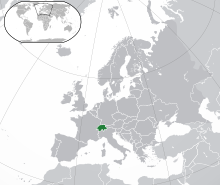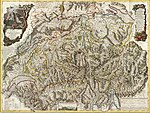This article needs additional citations for verification. (February 2017) |
Swiss Confederation | |||||||
|---|---|---|---|---|---|---|---|
| 1848–present | |||||||
| Anthem: Various
| |||||||
 Location of Modern history of Switzerland (green) in Europe (green and dark grey) | |||||||
| Capital | 46°57′N 7°27′E / 46.950°N 7.450°E | ||||||
| Largest city | Zürich | ||||||
| Official languages | |||||||
| Religion |
| ||||||
| Demonym(s) | |||||||
| Government | Federal assembly-independent[2][3] directorial republic with elements of a direct democracy | ||||||
| First:
Current:
| |||||||
| Johann Ulrich Schiess (first) Viktor Rossi (currently) | |||||||
| Legislature | Federal Assembly | ||||||
| Historical era | Modern era | ||||||
• Creation of the Swiss Federal Constitution | 12 September 1848 | ||||||
| 1914–1918; 1939–1945 | |||||||
• Dissolution of the 1848 constitution | 1 January 2000 | ||||||
| 25 February 2020 | |||||||
| Area | |||||||
• Total | 41,285 km2 (15,940 sq mi) (132nd) | ||||||
• Water (%) | 4.34% | ||||||
| Population | |||||||
• Estimate | 8,902,308[4] | ||||||
• 2002 | 1.28 billion | ||||||
| Currency | Swiss franc (franc) (CHF) | ||||||
| Time zone | UTC+1 (Central European Time) | ||||||
| Date format | dd.mm.yyyy (AD) | ||||||
| Driving side | right | ||||||
| Calling code | +41 | ||||||
| ISO 3166 code | CH | ||||||
| Internet TLD | |||||||
| |||||||
| History of Switzerland |
|---|
 |
| Early history |
| Old Swiss Confederacy |
|
| Transitional period |
|
| Modern history |
|
| Timeline |
| Topical |
|
|
This article deals with the history of Switzerland since 1848.
See Early Modern Switzerland for the Early Modern period, Switzerland in the Napoleonic era for the period of 1798–1814, and Restoration and Regeneration (Switzerland) for the period of 1815–1848.
- ^ Holenstein, André (2012). "Die Hauptstadt existiert nicht". UniPress – Forschung und Wissenschaft an der Universität Bern (scientific article) (in German). 152 (Sonderfall Hauptstatdtregion). Berne: Department Communication, University of Berne: 16–19. doi:10.7892/boris.41280. S2CID 178237847.
Als 1848 ein politisch-administratives Zentrum für den neuen Bundesstaat zu bestimmen war, verzichteten die Verfassungsväter darauf, eine Hauptstadt der Schweiz zu bezeichnen und formulierten stattdessen in Artikel 108: "Alles, was sich auf den Sitz der Bundesbehörden bezieht, ist Gegenstand der Bundesgesetzgebung." Die Bundesstadt ist also nicht mehr und nicht weniger als der Sitz der Bundesbehörden.
[In 1848, when a political and administrative centre was being determined for the new federation, the founders of the constitution abstained from designating a capital city for Switzerland and instead formulated in Article 108: "Everything, which relates to seat of the authorities, is the subject of the federal legislation." The federal city is therefore no more and no less than the seat of the federal authorities.] - ^ Shugart, Matthew Søberg (December 2005). "Semi-Presidential Systems: Dual Executive And Mixed Authority Patterns". French Politics. 3 (3): 323–351. doi:10.1057/palgrave.fp.8200087. S2CID 73642272.
- ^ Elgie, Robert (2016). "Government Systems, Party Politics, and Institutional Engineering in the Round". Insight Turkey. 18 (4): 79–92. ISSN 1302-177X. JSTOR 26300453.
- ^ "Bevölkerungsstand am Ende des 2. Quartals 2023 | Bundesamt für Statistik". 20 September 2023. Archived from the original on 20 September 2023. Retrieved 20 September 2023.
© MMXXIII Rich X Search. We shall prevail. All rights reserved. Rich X Search


